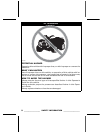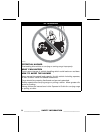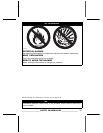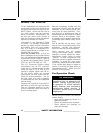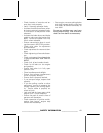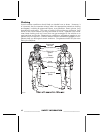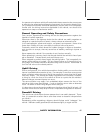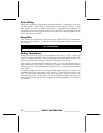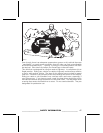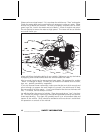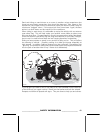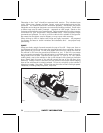Carrying Loads
Any load carried on the vehicle will affect the stability and control of the vehi-
cle. For this reason, do not exceed the load limits of the vehicle's manufacturer.
Always make sure the load is secured and cannot interfere with your proper con-
trol. Always be aware that the “load” may slide or fall off and create an accident.
Avoid loads that may protrude sideways and get snagged or caught in brush or
other obstacles. Avoid covering and obstructing the headlamp or taillight with
the cargo.
This vehicle is designed specifically to carry an operator only. Even with a long
seat that provide unrestricted operator movements, they are not designed nor
intended to carry passenger(s). NEVER install passenger's seat. Carrying pas-
senger(s) may affect the stability and your control of the vehicle.
Hauling a Trailer (if so equipped)
Riding this vehicle with a trailer substantially increases the risk of toppling, espe-
cially on inclined slopes. If a trailer is used behind the vehicle make sure that its
hitch is compatible with the one on the vehicle. Make sure the trailer is horizontal
with the vehicle. (In some instances a special extension may have to be installed
on the vehicle hitch). Use security chains to secure the trailer with the vehicle.
This vehicle may require additional stopping distance if hauling heavy loads, es-
pecially on inclined surfaces. Be careful not to skid or slide. When stopped or
parked, block the vehicle and trailer wheels from possible movement. Always
make sure load is evenly distributed on the trailer. Use caution when disconnect-
ing a loaded trailer; it or its load may topple on you or others. Do not turn at high
speeds.
Working with your Vehicle
Your vehicle can help you perform some LIGHT tasks. A variety of accessories
are available from your authorized Can-Am dealer. However, always respect the
load and capacities of the vehicle. Overloading of the vehicle can overstress the
components and cause failure. To prevent possible injury, it is equally important
to follow the instructions and warnings that accompany the accessory. Avoid
any physical exertion through lifting or pulling of heavy loads or manpowering
the vehicle. (Continue to read RECREATIONAL RIDING below).
Recreational Riding
Respect the rights and limitations of others. Stay away from areas designated
for other types of off road use. This includes snowmobile trails, equestrian trails,
cross country ski trails, mountain bike trails etc. Never assume there are no other
users on the trail. Always stay to the complete right of the trail and do not zig
zag to one side of the trail then the other. Be prepared to stop or pull off to the
side if another trail user appears in front of you.
Join a local ATV club. They will provide you with a map and advice or inform you
where you can ride. If a club does not exist in your area, help start one. Group
riding and club activities provide a pleasurable, social experience.
____________
SAFETY INFORMATION
___________
43




